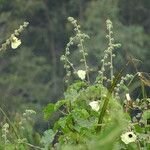A small shrub. It is often scrambling. It is often 1-2 m high but can be a medium sized tree up to 10 m tall. The bark is brownish-grey. The young branches are hairy and densely covered with prickles. The leaves are oval or round and 16 cm long by 16 cm wide. There are 3-7 distinct lobes. There are hairs on both surfaces, those underneath being longer. The edges of the leaves are irregularly toothed or scalloped. The leaf stalk is 12 cm long and hairy. The flowers are yellow or purplish, with a dark red centre. They are 8 cm long. The flowers occur singly in the axils of leaves. They can appear to be in groups towards the ends of branches. The fruit is an oval capsule. It is 2 cm long. It is sharply pointed. It is densely covered with silky golden hairs.
Shrub, 0.75-3.00 m high; stems with many stout conical prickles and with one or more lines of pubescence. Leaves ± ovate in outline, lower leaves deep palmately 3-7-lobed, lobes ± lanceolate, apex obtuse to acute, margins serrate, base cuneate to shallowly cordate with nectary. Flowers axillary, 1-3 at each node; peduncles articulating at base. Epicalyx bracts ± linear, bristly. Calyx 5-lobed, lobes lanceolate with conspicuous central nectary, densely covered with stiff bristles; becoming coriaceous at maturity. Petals obovate, cream-coloured to light yellow, purple-centred. Staminal tube 15-32 mm long; filaments 1-2 mm long. Flowering time all year. Fruit a densely appressed, pubescent capsule. Seeds subreniform, dark brown.
Stout perennial up to ± 2 m. tall, with stout stems, woody towards base and beset with sharp prickles. Lvs on stout petioles up to 8 cm. long; lamina 5-10 × 3-8 cm., broad-cordate to suborbicular, sts truncate, shallowly ± 3-5-lobed, scabrous, crenate-dentate. Fls 5-8 cm. diam., in terminal racemes, on short pedicels. Bracts lanceolate to 3-fid. Bracteoles 10, linear, ± 15 mm. long, hispid. Calyx densely clad in long stiff hairs, lobes lanceolate, ± 10 mm. long. Petals pale-to lemon-yellow, with basal dark purplish blotch, obovate, ± 3·5 × 3·5 cm. Capsule ± 2 × 2 cm., ovoid, acute to acuminate, hispid. Seeds pale brown, angled, glab., 4-5 mm. long.
Perennial to 2-(3) m high, woody at base; stems and petioles with spines 1-2 mm long. Lvs sparsely to densely clothed in simple hairs, suborbicular to ovate, not lobed or 3-5-lobed to usually < 1/2 radius, irregularly serrate, 2-10 cm long. Fls in terminal racemes, lowermost subtended by lvs; epicalyx segments 8-12, united at base only; calyx teeth triangular, > tube, moderately to densely hairy; petals yellow, dark-purplish at base, 30-60 mm long. Capsule enclosed by calyx; seeds smooth.
Erect, prickly perennial to 2.5 m. Leaves 3-5-palmate, coarsely toothed, on long, prickly petioles. Flowers shortly pedicellate in terminal racemes, large, pale yellow with dark eye, epicalyx of 10-12 linear lobes, staminal tube to 20 mm long; seeds concentric-scaly.

